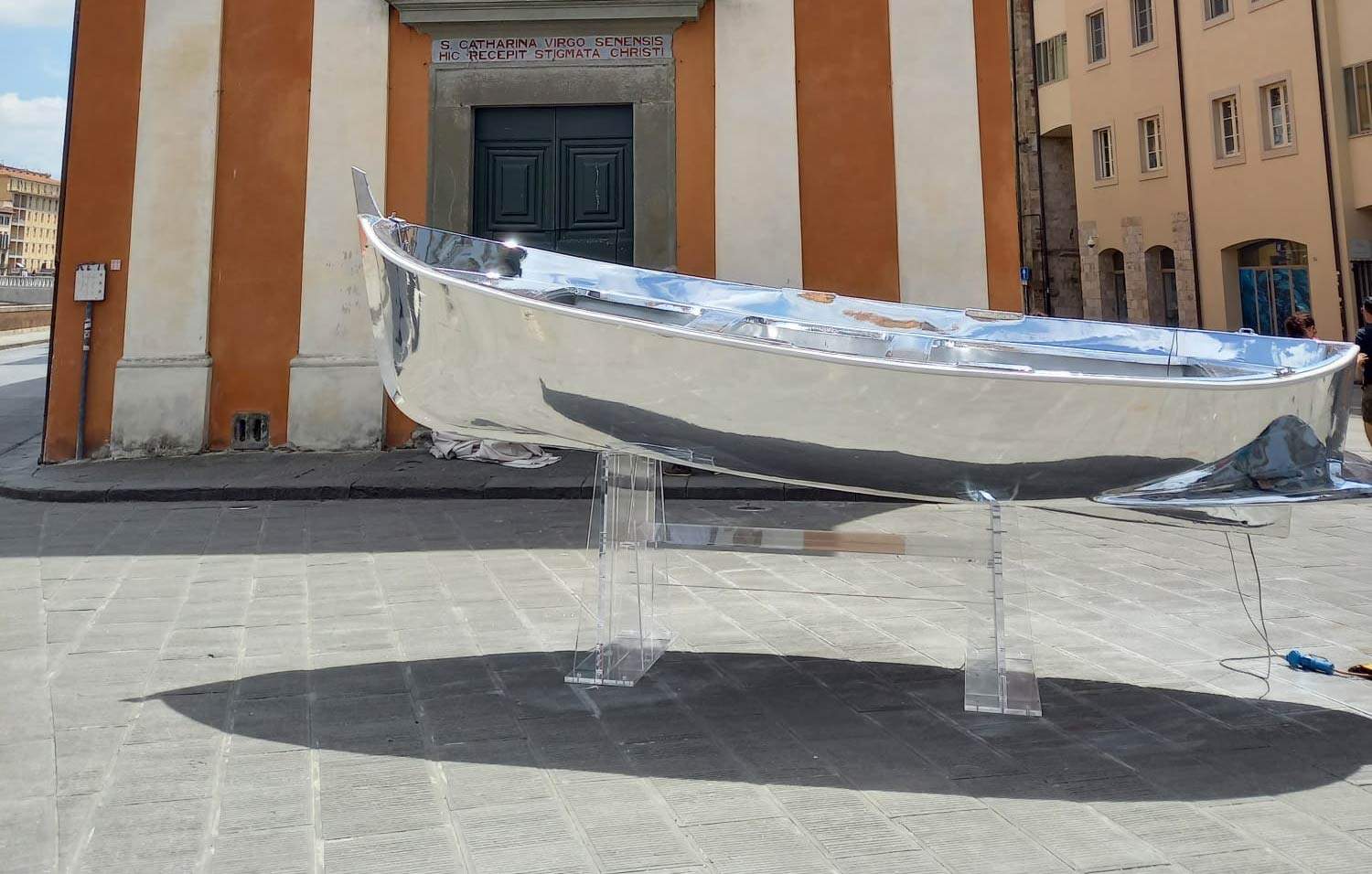Tannaz Lahiji's Boat of Charon arrives in Pisa on the Lungarno.
In Pisa, as of this morning, the Boat of Charon is ... stationary in front of the Lungarno. In fact, the third of the five events of the art project Beyond Dante, which the Persian artist Tannaz Lahiji, has dedicated to the city of Pisa on the occasion of Dante’s centenary, was inaugurated today, right in front of Palazzo Blu. Inaugurated last December inside the Church of the Thorn with the work Il Vortice Infernale (currently on display in the Municipal Library) and followed by Busto di Dante, the project continues with the presentation of the installation La Barca di Caronte, which will remain on display in the outdoor space in front of Palazzo Blu until July 10, and then will be transported to Piazza Gorgona, in Marina di Pisa. Beyond Dante is the second exhibition cycle created by artist Tannaz Lahiji and is curated by journalist and critic Manuela Antonucci. In fact, Dante had already inspired the artist in 2019 with another project, Reflections on Dante, dedicated to the city of Florence, also curated by Manuela Antonucci.
There will then be a further stage of the Dante project, an installation entitled Fontana Vorticosa, which will be placed near the Arsenali Medicei and the historic Guelfa tower. Guelph like Dante, who was sentenced to exile for it in 1302 and who will die in Ravenna on September 14, 1321.
“Pisa,” says the artist, “is a very poetic city, with beautiful sunsets, the air on its face, its silent and intimate streets, its welcoming light. A city with a lot of history and culture, monuments, museums.... A city famous for thePiazza dei Miracoli, the Scuola Normale, the University, but which has something more. A charm of its own. For all this I am honored to exhibit in this city. Then there is also the sea, and its Marina di Pisa is as beautiful as a postcard, the kind that is a bit old, that is no longer in fashion, and that you never tire of looking at... Here, I hope that my works can integrate and become a part of Pisa, but also a tool that can make the artistic experience live simply and naturally, during a walk in the city, chatting in a square; above all, I hope that this work becomes an opportunity to stop for an extra minute and reflect. To reflect on what each of us will see in thatboat. Charon’s Boat.”
“In human history, since the time of the ancient Egyptians, the boat has been and remains a moving symbol that has always represented the journey,” Antonucci explains. “In the case of artist Lahiji and his Boat of Charon, we are dealing with a journey that leads to unknown and deep places, to go beyond what we see and what we know: beyond the superficial knowledge of the world. And this is also the journey that Lahiji is making in his artistic quest. Unlike Narcissus, who uses mirroring only to confirm the value of his appearance, i.e., his illusory identity, Lahiji focuses on using the reflection (mirror) as a tool to look beyond his initial referencing, through which he glimpses the way to overcome appearances - surface mirroring, i.e., the sterile and puerile judgment of a predefined and comfortable truth - and to understand deep down what lies behind his outer image. Looking into that reflection (and tearing it open) he makes the journey into his abysses, which, if for Dante are represented by Hell, for Lahiji lead to the investigation of the self through his artistic quest.”
“A reflection far from the narcissistic one, indifferent to the voices of the unconscious - the voices of Echo for Narcissus - but rather a courageous and determined reflection, which listens attentively to the mysterious signals that her unconscious sends her and that Lahiji tries to decode and understand,” Antonucci concludes. “Insights that suggest to her to go beyond her judgment and Dante’s in order to tear apart the superficial image tout court. Tearing the veil of ignorance and fear, the artist attempts, albeit in a more laborious way, how to understand her truth, as a living person, woman, female and artist: her identity. Charon’s Boat is symbolic of her inner journey, into her own hell, into that dark and disturbing unconscious like the boats battered in the storms of the impetuous and untamable seas kneaded into the oils in Turner’s works. And for this voyage, she enlists the help of the viewer who, judging the reworking of her research-her installation The Boat of Charon-allows her to reach more authentic awarenesses to which she has not yet landed. A reflection that projects an image, perhaps different from the one we display in the world: but what do we keep within us? Perhaps dreams are what we nurture we guard, intimately, that make us alive, that remind us of who we are? The dream feeds the hope that keeps us going.”
 |
| Tannaz Lahiji's Boat of Charon arrives in Pisa on the Lungarno. |
Warning: the translation into English of the original Italian article was created using automatic tools. We undertake to review all articles, but we do not guarantee the total absence of inaccuracies in the translation due to the program. You can find the original by clicking on the ITA button. If you find any mistake,please contact us.




























